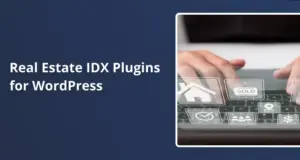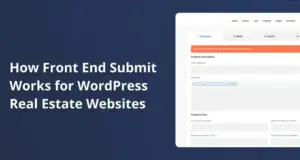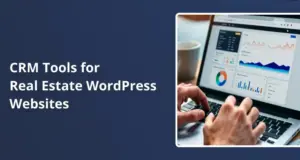If you run a real estate website on WordPress, showing live property listings from your Multiple Listing Service (MLS) isn’t just nice. It separates a credible site from one that visitors skip.
An IDX plugin (Internet Data Exchange) lets your WordPress site display current listings pulled directly from MLS databases. Instead of manually typing properties individually, you can show the entire market inventory. Buyers and renters see everything available, search by their criteria, and stay on your site longer. That’s the difference between a static brochure and a property search portal.
How IDX Plugins Connect Your Site to MLS Data
Think of an IDX plugin as a translator between your WordPress site and the MLS system. Here’s what you need to know about the setup.
First, you or your broker must be an MLS member with proper access credentials. The MLS has specific rules about displaying listings and may require data license agreements. Some charge fees or mandate specific disclaimers on your site.
Once you have access, the IDX plugin pulls listing information and displays it while following all MLS policies. The technical process varies depending on which plugin you choose, but they all serve the same basic purpose: getting property data onto your site.
Two Ways IDX Plugins Integrate With WordPress
IDX plugins use two fundamentally different approaches to show MLS listings on your site. Understanding the difference matters because it affects your site’s SEO, design flexibility, and overall performance.
Non-Organic IDX (iframe Display)
Many traditional IDX solutions embed listings through iframes or widgets. The actual property data lives on the vendor’s servers, not yours. Your site just displays a window into their system.
The upside? Setup is quick and straightforward. You don’t need coding skills; the listings always reflect the latest MLS updates since they pull directly from the vendor’s database.
The downsides add up, though. You get limited control over design and user interface. Often, every agent using that service has the same generic search layout. More importantly, search engines can’t properly index content inside iframes. Those property pages don’t really count as content on your domain.
For example, if IDX Broker uses a subdomain like homes.yoursite.com, Google treats it as a separate website. Your primary site doesn’t get credit for all that property content.
Organic IDX (Direct Data Import)
This approach actually imports MLS listings into your WordPress database. The properties become part of your site’s content, stored locally just like your blog posts or pages.
The older way to do this used RETS (Real Estate Transaction Standard). A plugin would connect to the MLS’s RETS server, query data using a special DMQL language, and import properties with all their photos and details.
The significant advantage: those listings now exist on your domain. Search engines can index them, and you control exactly how they display. Want them to match your theme’s design perfectly? No problem. Need mobile-responsive layouts? You’ve got complete freedom.
RETS had complications, though. Every MLS used different field names for basic things like price or address. Supporting multiple MLS feeds meant constant custom mapping work. You also needed a capable server to handle thousands of listings and images, plus ongoing maintenance to keep everything synced.
Modern Technology: RESO Web API
The real estate industry has been shifting away from RETS to something better: the RESO Web API.
RESO (Real Estate Standards Organization) created a RESTful, JSON-based API that standardizes how MLS data gets shared. Instead of learning each MLS’s unique data structure, developers work with consistent field names across different systems.
This makes life easier for everyone. Pulling listings from multiple MLSs doesn’t require reinventing solutions for each one. The API also supports an “Open Data” approach, letting you query information on the fly without storing massive databases locally.
Many newer WordPress IDX plugins run on RESO under the hood. Once you have MLS API credentials, importing properties becomes straightforward. The standardized format solves those old field-mapping headaches that plagued RETS.
Not every MLS has switched to RESO yet. Some still only offer RETS feeds. However, the trend points to RESO Web API as the standard.
What Features to Expect in IDX Plugins
Whether they use iframes, RETS, or RESO, most IDX plugins aim to provide a complete property browsing experience. Here’s what you’ll typically find:
Core Functionality:
- Current MLS listings with multiple layout templates
- Interactive property search with filters (location, price, bedrooms, bathrooms)
- Lead capture tools like contact forms and user registration
Good plugins make everything mobile-responsive. Since many homebuyers browse on phones, your property search must work smoothly on any screen size.
Popular extras include map-based search interfaces, saved searches that trigger email alerts, favorite listings for registered users, and integration with CRM systems so you can follow up on leads properly.
Why Your Real Estate Site Needs an IDX Plugin
Adding an IDX plugin to your WordPress site benefits you and your visitors.
Always Current, Always Complete
An IDX connection lets buyers search every available property in one place: your website. That beats showing just a handful of manually-added listings.
The plugin continuously syncs with the MLS. New listings appear automatically, and price changes update in real time. Sold or expired properties are removed without you lifting a finger. Your content stays fresh and relevant without the risk of someone calling about a house sold three weeks ago.
Detailed Property Information
MLS data includes everything buyers want to know: not just price and photos but square footage, bedrooms and bathrooms, year built, lot size, amenities, school district, and listing agent information.
Many plugins display multiple high-resolution photos per listing, virtual tour links, and neighborhood data. This depth keeps visitors on your site because they have everything they need.
Better Search Engine Rankings
You gain significant SEO advantages if you choose an IDX solution that imports listings into your database. All those property pages become indexable content under your domain name.
Each listing creates a page with an address, description, and local details. That’s dozens, hundreds, or thousands of pages that could attract search traffic. Someone Googling a specific address or neighborhood might land on your listing page instead of a big portal.
Over time, an organic IDX site accumulates indexed pages that help you rank for local real estate searches. Some agents using SEO-focused plugins have outranked large portals for specific queries because the MLS listings on their site count as relevant content.
Iframe-based IDX gives you little or no SEO benefit by comparison.
Engaging User Experience
IDX plugins typically include powerful search and filtering tools. Visitors can narrow results by location, price range, property type, and bedroom count. Advanced options let users draw custom search areas on maps or filter by specific features.
This level of interactivity matches what people expect from major real estate portals. A good IDX keeps users engaged instead of sending them elsewhere for better search tools.
Lead Generation Built In
Most IDX plugins come with lead capture features. They might prompt users to register to save a search or view full details. Contact forms on listing pages (“Request more info” or “Schedule a showing”) send inquiries straight to you.
Some platforms include CRM-like tools, such as automatic email alerts when new listings match a saved search or dashboards where you can see users’ activity and favorite properties. Your website actively helps with lead nurturing, automatically sending prospects relevant listings.
Time and Money Saved
Before IDX, agents manually entered and updated listings on their websites. This process was time-consuming and prone to errors.
IDX automation handles it for you. After initial setup, the system syncs new listings and updates every day or every hour. While some IDX solutions charge monthly fees, they’re typically more cost-effective than custom-developing your MLS integration from scratch.
Top WordPress IDX Plugins Compared
The WordPress ecosystem offers several IDX solutions, each with different strengths. Here’s what you need to know about the leading options.
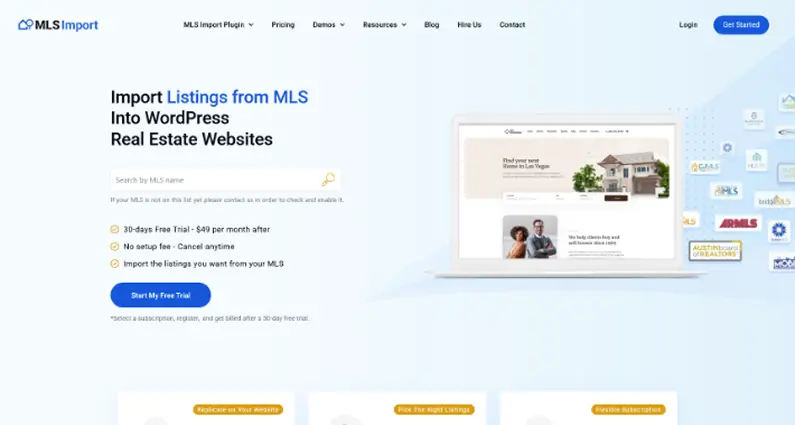
MLSImport
MLSImport represents the modern approach to IDX integration. It uses the RESO Web API to import MLS listings directly into your WordPress database.
Unlike older plugins that display data, MLSImport syncs properties into your site. It pulls new listings as they hit the MLS, updates prices and status changes, and automatically removes sold or expired properties.
You can filter which listings to import by city, price range, or property type, giving you control over exactly what appears on your site. MLSImport supports over 800 MLS markets across the US and Canada.
The plugin works with popular real estate WordPress themes like WPResidence, Houzez, and Real Homes. Since it brings data organically into your site, the listings appear as native content. This makes it very SEO-friendly with indexable pages for each property.
One smart feature is that listing images aren’t stored on your server. MLSImport serves photos via the MLS’s CDN, which speeds up your site and avoids bloating your hosting storage.
Pricing: $49/month or $504/year for unlimited listings after a 30-day free trial. Includes support and continuous updates.
MLSImport stands out for its all-in-one RESO API integration, letting agents skip the complications of outdated RETS technology.
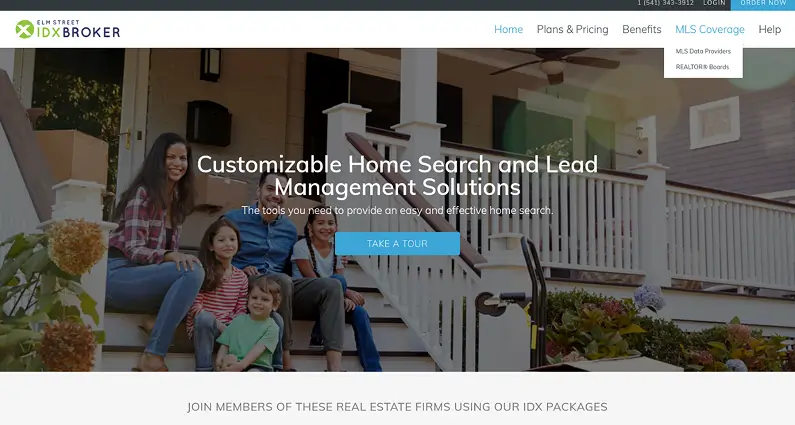
IDX Broker
IDX Broker is one of the longest-running and most widely used IDX platforms. It acts as a third-party service aggregating MLS listings nationwide and provides tools to embed them on your site via widgets, shortcodes, or custom pages.
The platform offers a comprehensive feature set, including map search, lead capture forms, saved search email alerts, customizable widgets for featured properties, and quick search forms.
IDX Broker’s biggest strength is its extensive MLS coverage. It integrates with more MLS boards than practically any other provider, so if you’re in a less common MLS area, IDX Broker likely supports it.
They also offer options for brokerages, such as roster pages for multiple agents and office-level accounts. The platform integrates with many CRMs, marketing tools, and even Zapier to help manage leads.
The consideration: IDX Broker’s default implementation uses an iframe or subdomain to display listings. This can hurt SEO since Google may treat it as separate from your leading site. Some developers work around this with custom subdomains or SEO settings, but it’s a known trade-off.
The interface is mobile-responsive, and you can style many elements to match your branding (though not as freely as an organic solution).
Pricing: The Lite plan costs around $55/month, and the Platinum plan, which has more features, costs $90/month, plus a one-time setup fee in some cases.

Showcase IDX
Showcase IDX has emerged as a leading WordPress IDX plugin focusing on modern user experience and strong SEO performance.
What sets Showcase apart is that it was built with SEO as a priority. It creates indexable listing pages on your WordPress site, so all the MLS content appears as native HTML on your domain, not in an iframe.
This means independent agents using Showcase IDX often get their listing pages ranking on Google, sometimes competing with large portals for local searches.
The features impress too. Showcase offers a slick, interactive search interface with a map that updates results live, autocomplete location search, and easy social sharing. Lead capture and engagement tools let visitors create accounts, save favorites, set up custom searches, and receive automated email alerts.
Agents can see user activity (search history, favorites) and message them through the system. The design is polished and responsive, giving an app-like feel that resonates with today’s buyers.
Showcase is known for ease of use. Many agents praise its clean admin interface and fast deployment. Customer service is reportedly very responsive and hands-on.
The limitations: MLS coverage. Showcase supports many MLSs, but not as many as IDX Broker. If your MLS isn’t in their network, you can’t use it. Also, Showcase doesn’t include sold listing data, which might matter if you want to show recent sales for context.
Pricing: The agent plan starts at about $74.95/month after a free trial (month-to-month, no long-term contract). Team/Office plans are available at higher tiers.
Showcase IDX is ideal for agents who want a cutting-edge, SEO-friendly IDX with great engagement tools, provided it supports their MLS.
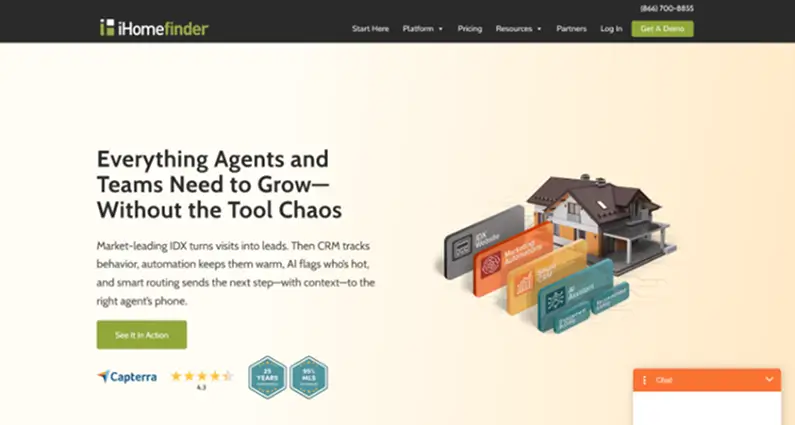
iHomefinder (Optima Express)
iHomefinder is a veteran in IDX solutions, combining IDX search with CRM and marketing features. Their WordPress plugin, often branded Optima Express + MarketBoost, embeds your site’s up-to-date MLS listings and market data.
You can easily add listing galleries or sliders to pages using shortcodes, plus create pages for property search and individual listings. Several search form types (quick search, address search, MLS ID search) let you place search bars in various contexts.
What distinguishes iHomefinder: integrated MarketBoost reports. These automated market reports and listing email updates add value beyond basic search. The platform includes a built-in lightweight CRM and email drip campaigns, automated emails for new listings, open home announcements, and a mobile app for managing leads.
From a technology standpoint, iHomefinder originally used RETS but has been updating to newer APIs. It’s a hosted solution (content served via their servers) with SEO-optimized content and fast loading. They offer indexable pages rather than pure iframes, which helps SEO.
Design templates are clean and somewhat customizable (you can match colors and styles), though their system determines the overall layout.
Pricing: The WordPress plugin is free to install, but you need an iHomefinder subscription to get data. Plans typically start at around $50-$60/month for the basic version and around $80-$100/month for versions that include MarketBoost and CRM features.
iHomefinder’s Optima Express is a strong option when you want more than just IDX search. It gives you marketing tools and a mini-CRM alongside IDX, though at a higher monthly cost with less flexibility than fully organic solutions.

Realtyna WPL (Organic IDX)
Realtyna offers an organic IDX solution through its WPL Real Estate plugin for WordPress. Realtyna’s approach treats your website like a full-featured real estate system.
WPL (WordPress Property Listing) is their base plugin that handles property listings as a custom post type. Their MLS Integration add-on imports MLS data.
The benefit is a strong SEO and customization focus. Since it stores listings in your site’s database, the content is indexable, and you control how it displays. WPL allows extensive customization of fields, custom search forms, and various widgets and templates.
It’s used worldwide, integrating many MLS feeds across North America. A key point: Realtyna is mostly a self-hosted solution. You buy the software, and the data lives on your server. Some brokers prefer this for data ownership reasons.
WPL Pro includes advanced search, mapping, lead capture, and compatibility with several WordPress themes or their own add-on themes. The MLS add-on uses RETS or RESO API (depending on the MLS) to import listings on a schedule.
Being self-hosted means you’ll need a capable server for thousands of listings, but the advantage is that everything can reside locally or on a CDN you control.
Pricing: Unique model. The base WPL plugin has a free version (for manual listings) and a paid WPL Pro (around $199 one-time) for full features. MLS integration is a separate add-on priced at around $950 one-time plus $49/month for each MLS feed you connect.
The upfront cost is high (nearly $1,150 for one MLS feed integration), but after that, you mostly pay the $49/month feed maintenance. This one-time purchase model appeals to those who dislike endless monthly subscriptions.
Realtyna WPL is a top choice for an enterprise-grade, self-hosted IDX that’s very SEO-friendly and customizable. Suitable for larger agencies or tech-savvy site owners who want complete control and are willing to invest upfront.
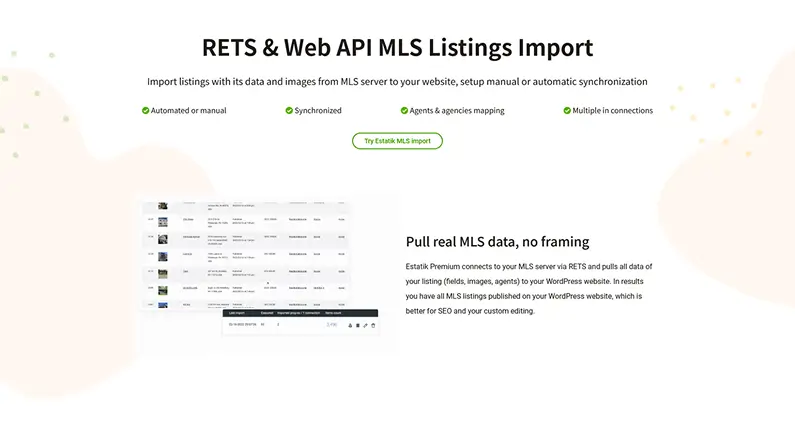
Estatik Premium
Estatik is a WordPress plugin that provides in-house listing management and MLS import capabilities. It is known for its user-friendly interface and attractive property layouts.
Estatik is an IDX solution in its Pro and Premium versions that imports listings via RETS/RESO feeds. You configure it with your MLS credentials, and it fetches listings into your site’s database.
Key features include customizable property templates (you can adjust what information shows and add custom fields), advanced search with filters, Google Maps integration, and front-end property submission (useful if you allow agents to add their own listings).
It supports multiple languages and has translation compatibility, which works well for multilingual markets. Estatik is built to work with several real estate themes and is generally easy to style.
One advantage: Estatik offers a free base plugin (Estatik Lite) for a basic real estate site with manual listings. Upgrading to Estatik Pro (about $89 for 6 months of support/license) adds more features but still relies on manual data input.
Full MLS integration, including RETS/RESO import functionality, comes with Estatik Premium, a one-time cost of $649. This premium pack supports one MLS feed setup (their team often helps configure it).
The plugin has been updated to support RESO Web API as MLS providers adopt it. Using Estatik Premium is like having your own mini-MLS system running on WordPress. It routinely imports new and updated listings, keeping your site current.
You get the SEO benefit since listings are local, and you have lots of control over how things look. The main consideration is that running a full MLS import with potentially thousands of listings means you need decent hosting and some technical understanding.
Pricing: One-time cost of $649 for Premium with MLS integration makes it cost-effective for those who want integrated IDX but can’t afford high recurring costs.
Estatik is solid for small brokers or individual agents who want to start with a free version and scale up.
Other Notable IDX Solutions
Beyond the major players, a few other IDX tools deserve mention:
SimplyRETS provides developers an easy way to pull MLS data via RETS/RESO and output it on a WordPress site. They offer a plugin for basic integration. The approach is more API-centric and favored by those building custom designs. It renders listings as standard HTML (not iframes) for SEO, but requires a monthly subscription and some configuration.
Rover IDX is another WordPress IDX plugin that focuses on flexible search and display. It allows extensive personalization in how listings appear and supports multiple MLS feeds. Pricing is tiered by the number of agents, starting around $65/month for a single-agent site.
The Flexmls IDX Plugin works if your MLS is part of the Flexmls system. It can embed live MLS data and widgets on your WordPress site, with real-time data directly from the Flexmls platform and good SEO. The plugin is priced at roughly $499/year for agents.
EstateVue IDX is tailored for Canadian boards and caters specifically to Canadian real estate professionals. It features city-specific listings, a map/grid toggle, and a home evaluation tool.
Choosing the Right IDX Plugin for Your Needs
When selecting an IDX plugin, weigh these factors:
MLS Coverage – Does the plugin support your local MLS? This is non-negotiable. Check before you commit.
Integration Method – Do you want organic integration (better SEO, more control) or are you okay with iframe/hosted solutions (more straightforward setup, less SEO benefit)?
Budget – Consider both upfront and ongoing costs. Monthly subscriptions can add up over the years. One-time purchase options might cost more initially but less long-term.
Technical Comfort: Self-hosted solutions with data import require better hosting and some technical knowledge, while hosted solutions are more plug-and-play.
Design Flexibility: How much do you need to customize the look? Organic solutions give you full control, while hosted solutions have limitations.
Lead Tools – Evaluate the lead capture, CRM integration, and email alert features. Some plugins excel here.
Support – Good customer support matters when dealing with complex MLS integrations. Check reviews.
The best choice depends on your specific situation. If you’re tech-savvy and want maximum SEO, look at MLSImport, Realtyna WPL, or Estatik Premium. IDX Broker makes sense if you need extensive MLS coverage with minimal hassle. For modern UX and strong SEO in supported markets, consider Showcase IDX.
A quality IDX plugin transforms your WordPress real estate site from a static brochure into a dynamic property search portal. The technology has come a long way, from clunky RETS implementations to streamlined RESO Web API integrations.
The right IDX plugin saves you time, improves your search engine visibility, engages visitors with powerful search tools, and helps convert browsers into leads. With options ranging from $49/month to several hundred dollars for one-time purchases, there’s an IDX solution for every budget and technical comfort level.
Take time to evaluate what matters most for your site. Your MLS coverage area, SEO goals, budget constraints, and technical abilities should guide your decision. Most plugins offer free trials, so test before you commit.






